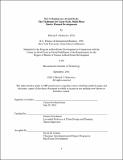New urbanism on a grand scale : the challenges for large-scale, multi-phase master planned developments
Author(s)
Olchowicz, Edward J
DownloadFull printable version (16.79Mb)
Other Contributors
Massachusetts Institute of Technology. Center for Real Estate. Program in Real Estate Development.
Advisor
Dennis Frenchman.
Terms of use
Metadata
Show full item recordAbstract
New Urbanism has been described as an urban design movement promoting the master planning and development of communities that have walkable, human-scale neighborhoods while integrating the necessary elements of modern life such as vehicular traffic and parking, wide ranging retail offerings, and diverse employment centers. As its core, New Urbanism attempts to counter the multitude of problems stemming from the rise of automobile transport and resulting mass migration to the suburbs in the 20th Century, including sprawl, a lost sense of local community, lack of diversity, untenable housing and transportation costs, arduous commuting times, negative environmental impacts, and harmful effects to individuals' physical health. There have been a number of smaller -- "town-scale" -- New Urbanist developments built since the movement gained traction and formal organization in the 1980s. These communities have proved their mettle not only as positive social engineering experiments, but also as profitable business models for real estate entrepreneurs. The context for New Urbanism has changed greatly over the past several decades. Today, design and development firms are undertaking the construction of secondary cities and urban nodes with housing units numbered in the tens of thousands and areas measured in hundreds of acres. These "city-scale" developments carry risks and uncertainties that eclipse the rather controllable and largely foreseeable nature of small town development by requiring exponentially larger amounts of capital over periods typically extending more than a decade. The phasing in of the wide array of product types call for clear vision, steady leadership, and stalwart relationships, despite the real challenges of fickle political support, unpredictable economic cycles, and increasingly opportunistic labor pools. The thesis will primarily focus on Miasteczko Wilanow, a master planned community in southern Warsaw, Poland. Supplemental research, through comparisons to Kentlands, Maryland and Pinehills, Massachusetts, will be presented. Through on-site interviews and analysis of historical documentation, the thesis will aim to 1) present the initial considerations and intentions of Miasteczko Wilanow; 2) chart the development's progress and evolution from groundbreaking to present day; and 3) present conclusions and potential solutions towards better planning and implementation of similar "city-scale" projects.
Description
Thesis (S.M. in Real Estate Development)--Massachusetts Institute of Technology, Program in Real Estate Development in Conjunction with the Center for Real Estate, 2011. This electronic version was submitted by the student author. The certified thesis is available in the Institute Archives and Special Collections. Cataloged from student-submitted PDF version of thesis. Includes bibliographical references (p. 98).
Date issued
2011Department
Massachusetts Institute of Technology. Center for Real Estate. Program in Real Estate Development.; Massachusetts Institute of Technology. Center for Real EstatePublisher
Massachusetts Institute of Technology
Keywords
Center for Real Estate. Program in Real Estate Development.